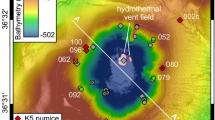Abstract
The distribution of rare-earth elements in surface and underground waters, water-bearing rocks, and secondary mineral neoformations of thermal waters of the Paratunka and Vilyuchinsk hydrothermal systems of Kamchatka has been studied. It is revealed that their content, distribution, and fractionation differ with respect to the geochemical type of water and the pH–Eh of the aquifer. All waters are characterized by the domination of the transportation of dissolved rare earth elements, which exceeds their transportation with colloids by 1000 times. It has been shown that neoformations of carbonates, sulfates, and silicates, including calcite, gypsum, and amorphous opal, are widespread in the discharge areas of the studied thermal waters. The redistribution intensity of rare earth elements in the rock–water–secondary deposits system is very low in waters of the sulfate type, where the elements are bonded to sulfates. At the same time, the precipitation of rare earth elements as newly formed mineral phases is most intensive in water with carbonate complexes.





Similar content being viewed by others
REFERENCES
Blokhin, M.G., Chudaev, O.V., and Zarubina, N.V., Determination of element composition of the suspended particulate matter in the waters of Primorye rivers using plasma spectrometry methods, in Mater. Vtoroi Vseross. konf. s mezhd. uchastiem “Geologicheskaya evolyutsiya vzaimodeistviya vody s gornymi porodami” (Proc. All-Russ. Conf. with Int. Participation “Geological Evolution of the Water–Rock Interaction”), Vladivostok: Dal’nauka, 2015, pp. 555–558.
Borovtsov, A.K. and Markovskii, B.A., Gosudarstvennaya geologicheskaya karta Rossiiskoi Federatsii. Masshtab 1 : 200 000. Seriya Yuzhno-Kamchatskaya. List N-57-XXVI, Ob”yasnit. Zapiska (The 1 : 200 000 State Geological Map of the Russian Federation. South Kamchatka Ser. Sheet N-57-XXVI. Explanatory Note), St. Petersburg: Vseross. Nauchno-Issled. Geol. Inst., 2002.
Bragin, I.V., Kharitonova, N.A., Chelnokov, G.A., et al., REY geochemistry in groundwater from Paratunka geothermal area (Kamchatka peninsula, Far East of Russia), Environm. Earth Sci., 2018, vol. 77, pp. 376–389. https://doi.org/10.1007/s12665-018-7571-7
Chudaev, O.V., Sostav i usloviya obrazovaniya sovremennykh gidrotermal’nykh sistem Dal’nego Vostoka Rossii (Composition and Origin of the Recent Hydrothermal Systems of the Russian Far East), Vladivostok: Dal’nauka, 2003.
Chudaev, O.V., Chudaeva, V.A., Karpov, G.A., et al., Geokhimiya vod osnovnykh geotermal’nykh raionov Kamchatki (Water Geochemistry of Main Hydrothermal Areas of Kamchatka), Vladivostok: Dal’nauka, 2000.
Chudaev, O.V., Chelnokov, G.A., Bragin, I.V., et al., Geochemical features of major and rare-earth element behavior in the Paratunka and Bol’shebannyi hydrothermal systems of Kamchatka, Russ. J. Pacific Geol., 2016, vol. 35, no. 6, pp. 458–475.
Chudaev, O.V., Kharitonova, N.A., Chelnokov, G.A., Bragin, I.V., and Kalitina, E.G., Geokhimicheskie osobennosti povedeniya redkozemel’nykh elementov v vodakh Dal’nego Vostoka Rossii v usloviyakh prirodnykh i antropogennykh anomalii (The Geochemical Behavior of Rare Earth Elements in Waters of the Russian Far East in Environments of Natural and Manmade Anomalies), Vladivostok: Dal’nauka, 2017.
Chudnenko, K.V., Selektor–Windows: Programmnoe sredstvo rascheta khimicheskikh ravnovesii minimizatsiei termodinamicheskikh potentsialov. Kratkaya instruktsiya (Selector-Windows: A Program Tool for Calculation of Chemical Equilibria by Minimization of Thermodynamic Potentials. A Brief Manual), Irkutsk, 2003.
Elderfield, H., Upstill-Goddard, R., and Sholkovitz, E., The rare earth elements in rivers, estuaries, and coastal seas and their significance to the composition of ocean waters, Geochim. Cosmochim. Acta, 1990, vol. 54, pp. 971–991.
Karpov, G.A., Nikolaeva, A.G., and Alekhin, Yu.A., Abundances and sources of rare-earth elements in the modern volcanogenic hydrothermal systems of Kamchatka, Petrology, 2013, vol. 21, no. 2, pp. 145–157.
Kharitonova, N.A., Vakh, E.A., Chelnokov, G.A., et al., REE geochemistry in groundwater of the Sikhote Alin fold region (Russian Far East), Russ. J. Pacific Geol., 2016, vol. 10, no. 2, pp. 141–154.
Manukhin, Yu.F. and Vorozheikina, L.A., Hydrogeology of the Paratunka hydrothermal system and conditions of its formation, in Gidrotermal’nye sistemy i termal’nye polya Kamchatki (Hydrothermal Systems and Thermal Fields of Kamchatka), Vladivostok, 1976, pp. 143–178.
Naboko, S.I., Two genetic groups of volcanic waters and their mineralogical and ore-forming significance, in Sovremennye mineraloobrazuyushchie rastvory (Modern Ore-Forming Solutions), Petropavlovsk-Kamchatsky, 1970, pp. 7–8.
Naboko, S.I., Evolution of hydrothermal systems and their ore potential, in Evolyutsiya vulkanizma v istorii Zemli (Evolution of Volcanism in the Earth’s History), Moscow: Nauka, 1974, pp. 391–400.
Naboko, S.I., Karpov, G.A., and Glavatskikh, S.F., Mineralogical–geochemical features of the Apapel thermal springs, Byull. Vulkanol. St., 1977, no. 53, pp. 102–110.
Novgorodova, M.I., Veretennikov, V.M., Boyarskaya, R.V., and Drynkin, V.I., Geochemistry of trace elements in gold-bearing quartz, Geokhimiya, 1984, no. 3, pp. 370–383.
Svetova, E.N., Svetov, S.A., and Danilevskaya, L.A., Rare and trace elements in quartz as indicators of mineral formation conditions, Tr. Kar. NTs RAN, 2012, no. 3, pp. 137–144.
Taylor, S.R., Abundance of chemical elements in the continental crust: a new table, Geochim. Cosmochim. Acta, 1964, vol. 28, no. 8, pp. 1273–1285.
Funding
This work was supported by the Far Eastern Branch of the Russian Academy of Sciences, project no. 18-2-003. The study of distribution of rare earth elements in waters of the Paratunka and Vilyuchinsk thermal systems was supported by the Russian Science Foundation, project no. 18-17-00245.
Author information
Authors and Affiliations
Corresponding authors
Additional information
Translated by I. Bel’chenko
About this article
Cite this article
Chelnokov, G.A., Kharitonova, N.A., Bragin, I.V. et al. The Geochemistry of Rare Earth Elements in Natural Waters and Secondary Mineral Sediments of Thermal Fields of Kamchatka. Moscow Univ. Geol. Bull. 75, 196–204 (2020). https://doi.org/10.3103/S0145875220020027
Received:
Revised:
Accepted:
Published:
Issue Date:
DOI: https://doi.org/10.3103/S0145875220020027




